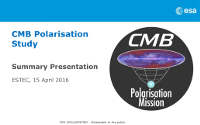ESA Science & Technology - Publications Archive
Publication archive
Publication archive
ESA's Concurrent Design Facility (CDF) has completed a short study of a Cosmic Microwave Background Polarisation mission (CMB Polarisation) to support the European and Japanese science community in defining a collaborative mission studying the Polarisation of the Cosmic Microwave Background for calls for Cosmic Vision Medium-sized mission.
Further details can be found in the CDF presentation linked below and from the image to the right.
A summary presentation can be found here.
ESA's Concurrent Design Facility (CDF) has completed a short study of a Cosmic Microwave Background Polarisation mission (CMB Polarisation) to support the European and Japanese science community in defining a collaborative mission studying the Polarisation of the Cosmic Microwave Background for calls for Cosmic Vision Medium-sized mission.
A summary can be found in the CDF presentation linked below and from the image to the right.
A more detailed presentation can be found here.


